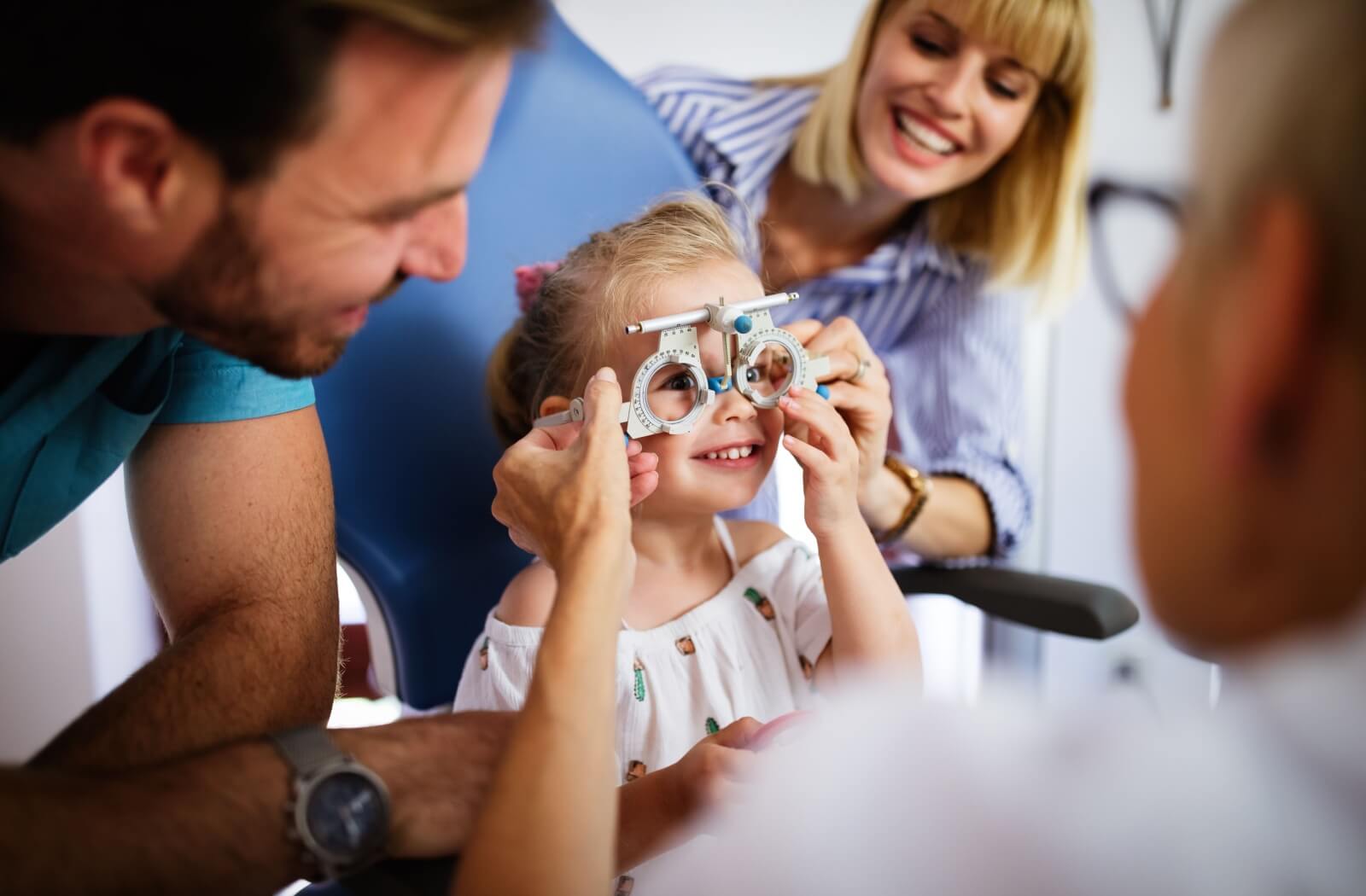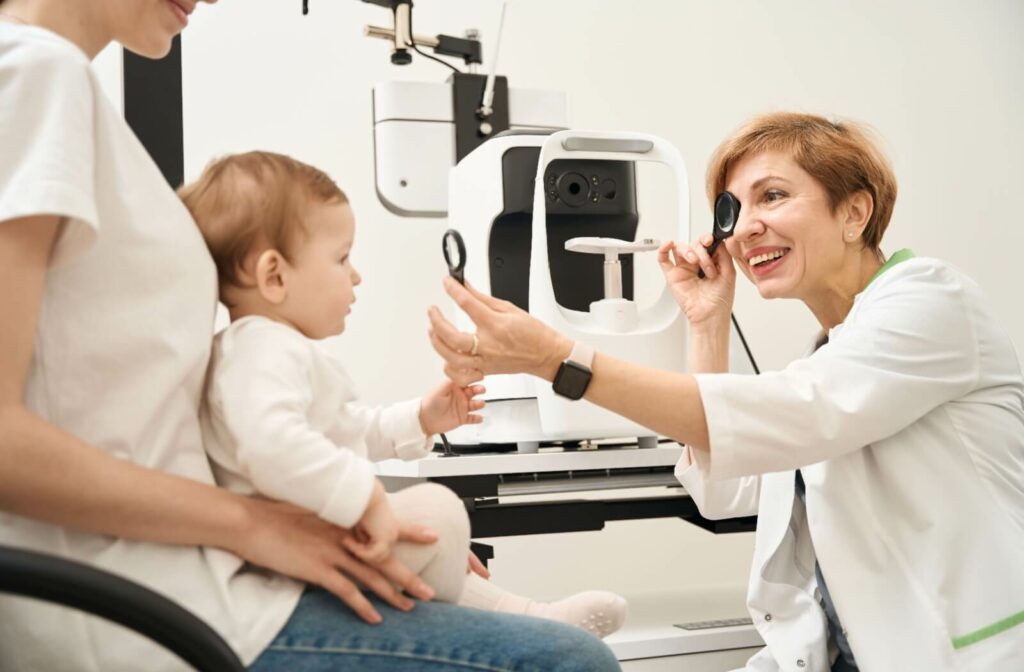Ensuring your child has healthy vision is crucial for their overall development and success in school and life; but new parents can often wonder when it’s appropriate to bring their baby in for their first eye exam as well as how often to bring them back.
Whether you’re a new parent or want a refresher for how to best care for your child’s eye health, it’s recommended that children have their first eye exam between 6-12 months old, another between ages 3-5, and then annually the year before first grade through adolescence. A dedicated eye care team can help support your child’s eye health throughout their childhood.
Eye Examination Frequency By Age
Birth Through 2
There are many milestones in a baby’s visual progression, including:
- Birth to 4 Months: Your baby’s vision is improving rapidly at this stage. They should be focusing on nearby objects and faces and begin to reach for things
- 5 to 8 Months: A 3-dimensional view of the world begins to form, as does color vision
- 9 to 12 Months: Babies begin to grasp objects and can judge distances
- 1 to 2 Years: Hand-eye coordination and depth perception should be well-developed
Since eye development changes so rapidly at this age, infants are recommended a single eye exam between 6-12 months old. Starting eye exams early can help detect problems like amblyopia (lazy eye) or congenital cataracts. Catching these issues early allows for interventions that can improve your child’s vision and prevent long-term complications.
At this age, exams are generally non-invasive. The optomoterist will look at how well your baby’s eyes respond to light and movement using toys or lights. You can encourage your baby’s healthy visual development by playing games with them.
3 Through 5
A second eye exam is recommended for children once they reach between the ages of 3 to 5. This is because children aren’t born with the visual skills they need – they develop them over time, just like the ability to walk and talk. In fact, nearly 80% of what children learn happens through their vision.
Prioritizing a comprehensive eye exam for your child at this age is an important aspect of setting your child up for success. Your eye doctor can make the process fun and engaging for your child while still assessing visual acuity, eye alignment, and depth perception. These exams also help detect early signs of vision problems such as difficulties in recognizing shapes, colors, or letters or issues like strabismus (crossed eyes) or refractive errors (nearsightedness or farsightedness).
While one eye exam during this age is recommended, if you notice that your child squints, tilts their head, or covers one eye, you can schedule another one, since these might be signs of a vision problem. Remember that children don’t know what is and isn’t considered “normal vision” at this age. Addressing issues early can significantly improve your child’s quality of life.
6 Through 17
School-age children and teenagers should have an eye exam every year, starting the year before first grade. Regular exams during these years are crucial because vision can change rapidly as children grow. These eye exams are mor thorough than for babies and toddlers, including tests for visual acuity, eye alignment, and focusing skills.
If you have a family history of vision problems, color blindness, diabetes, or other specific conditions that impact eyesight, you can ask your eye doctor to check for these conditions during your child’s exam.
Clear vision is essential for reading, writing, and participating in classroom activities. Children who start school with undiagnosed vision problems may struggle to keep up in class, leading them to potentially be misdiagnosed with ADHD or another behavioral disorder.
Undiagnosed vision problems can also lead to:
- Learning at a slower rate than their peers
- Impacts on academic performance
- Lowered self-esteem
- Behavioral and disciplinary problems
- Higher risk of dropping out of school
Pay attention to complaints of headaches, eye strain, or difficulty concentrating. These could be signs that your child needs glasses or has other vision issues.

Importance of Regular Eye Exams for Children
Good vision is linked to better academic performance, improved social interactions, and a higher quality of life. Remember that regular eye exams are not just about checking vision; they’re about ensuring your child’s overall well-being:
- Preventative Care to catch problems before they become severe; early intervention can prevent conditions from worsening and even reverse some issues.
- Holistic Health through eye exams since they can sometimes detect other health problems, such as diabetes or hypertension, which can manifest in the eyes before other symptoms appear
- Building Confidence in children in and out of school, since clear vision encourages them to participate in activities and explore their interests
Vision Problem Symptoms in Children
Children may not always realize they have vision problems, and if they do, they may not know how to tell you. Regularly scheduled eye exams can make it easier for children to bring up issues they’re experiencing with their doctor they may not think to mention to you.
However, you can be proactive in taking care of their vision help by keeping an eye out for common symptoms that your child’s vision may be bothering them:
- Frequent eye rubbing or blinking
- Short attention span for age-appropriate tasks
- Avoiding detailed activities like coloring or reading
- Complaints of headaches or eye strain
- Holding objects very close or sitting too close to the TV
- Difficulty with hand-eye coordination
- Trouble reading the board in school
- Falling behind in class
- Difficulty with reading comprehension
Experiencing vision problems can also make your child more reluctant to see an eye doctor. You can help them prepare for eye exams by explaining the process, making it fun, and planning ahead.At The Vision Place we care for each patient as if they were a good friend of the family. Contact us today to see if Dr. Palomino and The Vision Place are a good fit for supporting your child’s eye developmental journey.


